







Visit with the Patriarch
May 13, 2006 - Post No. 78
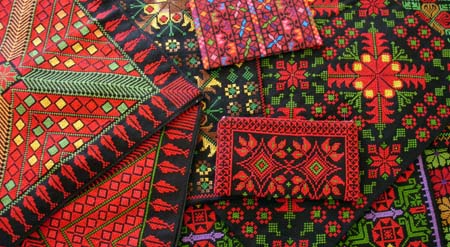
Saturday morning in Bethlehem I follow the same schedule as the previous morning, rising with the Moslem alarm clock next door, Matins in the Church of the Nativity, a brisk morning walk, cappuccino at the Franciscan hotel, and the Badarak in the Grotto of the Nativity. When I approach the same bread seller on Manger Square from whom I purchased one of the typical elongated Palestinian bagels the day before, he greets me like an old friend and attempts to teach me the few words in Arabic needed for the transaction. These Palestinians really are a cordial lot!
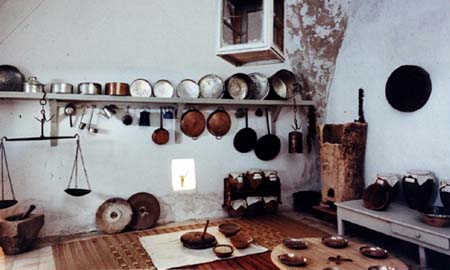
Following the Badarak, I have time for a last walk
through the market district of Bethlehem that is awaking from the Moslem
Sabbath with a flourish, no doubt a busy day lies ahead. My main
objective is to visit the
Arab Women's
Union Arts and Crafts Centre and Folk Museum.
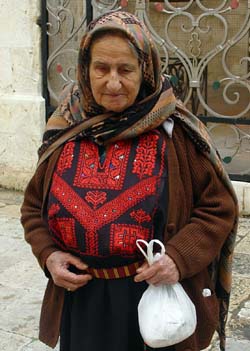 The
Arab Women's Union occupies a couple of historic homes in the old
Christian Quarter of Bethlehem, which they have furnished and decorated
according the the style of Christian homes in Bethlehem the mid to late 19th century.
The
Arab Women's Union occupies a couple of historic homes in the old
Christian Quarter of Bethlehem, which they have furnished and decorated
according the the style of Christian homes in Bethlehem the mid to late 19th century.
They also have a wonderful gift shop filled with a colourful array of hand stitched product (top picture) including clothing, cushion covers, table cloths, and other household items. It is said that each Palestinian family has its own distinctive stitching style, like the breast plate the women pictured here is wearing. The pattern identifies her family or tribal association. Sometimes these intricate patterns run down the full front length of the traditional dress.
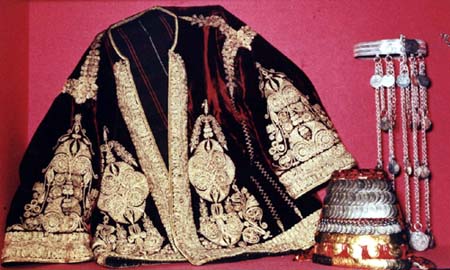
The director of the Arab Women's Union tells me that the increase in tourism is not being felt in the streets of Old Bethlehem. Most tourists make the trip to Bethlehem for only a couple of hours, getting off the bus to visit the Church of the Nativity and then, when the visit is over, back on the bus for the return trip to Jerusalem.
The effect is that the economy of Bethlehem is still barely scrapping by. Here's an early Christmas shopping idea for you, consider placing an order for some of the hand stitched product of the Arab Women's Union -- it is possible to place orders online at www.arabwomenunion.org. Not only can you count of the quality of the work, but you can be certain that your dollars end up directly in the hands of the Bethlehem craftswomen themselves.

Sarkis is waiting for me when I return to the Armenian Convent, and he drives me back to Jerusalem through the security crossing pictured above.
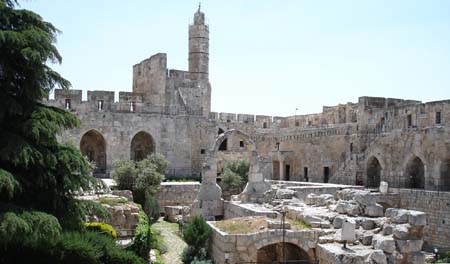
There are a couple of things on my "to do list" for this next-to-last day in Jerusalem. Leading the list, a visit to the Citadel, also known as the Tower of David (though the site would have been bare ground in David's day) at Jaffa Gate. The Citadel dates to the Hasmonean period (2nd century before Jesus), and was continuously occupied by the various military authorities that have governed the city for more than two thousand years, up until the 1967 war that saw the Israelis gain control over the old city and all of Jerusalem.
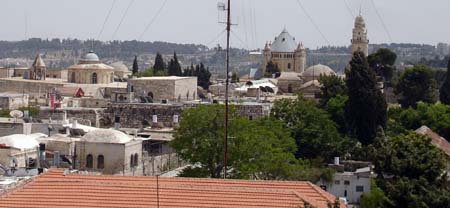
The Citadel's central tower offers a splendid view of the old city, and I take this opportunity to enjoy a bird's eye perspective of the Armenian Quarter, pictured above. The truncated dome of the Cathedral of SS James can be seen towards the left. The Patriarch tells me that it was once a much taller cone-topped Armenian octagon -- in the typical style of Armenian churches -- but was cut down during the Ottoman regime, because the Sultan thought it looked too much like a mosque.

The Citadel has been converted into a museum dedicated to telling the story of the city of Jerusalem. Each of the rooms of the former military fortress has been organised around a specific period in the history of the city. The model of the City of David, pictured above, is found in the room dedicated to that early period (3000 years ago). It shows how the City of David was much lower on Mount Moriah than is the Jerusalem we know today. In this model, above, the future site of the Temple Mount is represented by the famous hard rock jutting out of the hill's summit, upper right in the photo above -- traditionally the site of Abraham's attempted sacrifice of his son, Isaac.
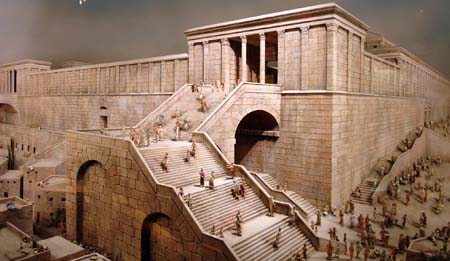
The model of Herod's temple (pictured here) is quite impressive. On Wednesday, I joined a walking tour that visited the Western Wall Tunnel that runs along the base of the temple's western wall, facing above. The 500 metre long outside edge of Herod's man made plateau or platform still supports the Temple Mount itself, and only about 60 meters of this make up the outdoor portion of the Wailing Wall.
Much of the area to the south of the temple (right, above) down into the old City of David (pictured, above) has been unearthed and can be visited in a beautiful archaeological park below the southeast corner of the old city, where it is possible to stand on the very steps which Jesus would have climbed on his way to the Temple.

Armenian (Kutahyian) painted ceramics, Marie Ballian,
2004
Returning from the museum, I attend to the second item on my list of things-to-do today and stop to visit the shops of two Armenian ceramic tile producers, neighbouring the Armenian Convent in Old Jerusalem.

Armenian refugees fleeing the Armenian Genocide, brought the craft of ceramic tile painting to Jerusalem from their native province of Katahy in Turkey. Vic Lepejian, pictured above, and his son operate a small store and workshop slightly below street level, a few metres from the entrance to the Armenian convent. Vic has just completed the tile painting pictured behind him, representing St. Mesrob and the Armenian alphabet he is credited with inventing.
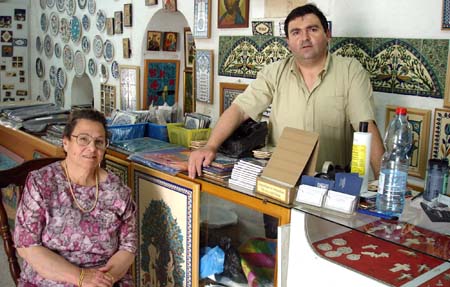
Next stop is the Armenian Art Center Sandrouni, where Kevork (George) Sandrouni and his mother are on hand to welcome visitors to their shop. George is pleased to show me around his workshop, and explains the stages in the production of painted ceramics.
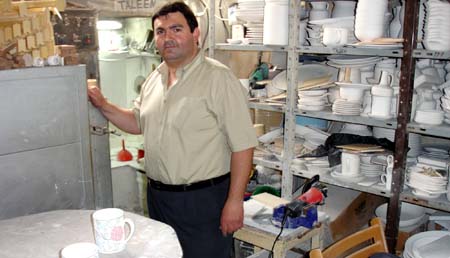
A portrait of the Catholicos of all Armenians, Karekin II of Etchmiadzin has a prominent place (pictured right) in the Sandrouni ceramics workshop.
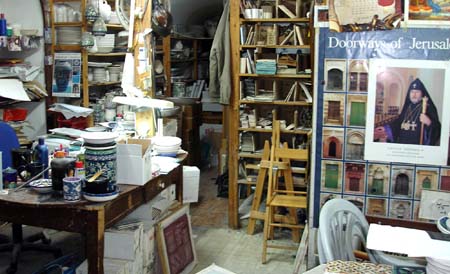
I return to the Armenian Convent in time for Vespers, and Fr. Issahak, personal assistant to the Patriarch, tells me that His Beatitude will have time to meet with me following the service. I waived the customary introductory meeting with the Patriarch on my arrival in Jerusalem, realising that he would be swamped with official visitors and duties over the Easter period. In fact, he seems to be very busy most of the time, and I am thankful for a few minutes of his time today.

I am particularly pleased to meet Patriarch Torkom II, because it was under his leadership that a wonderful book was produced that has been my steady companion for the past four months. Before his election as Patriarch, when he was still serving as the Primate of the Armenian Church of America, Eastern Diocese, Torkom Serpazan commissioned the production of a bilingual missal for the Divine Liturgy of the Armenian Church. The book not only offers an English translation of the Badarak, but it also provides a transliteration of the Armenian using the European alphabet making it possible for a visitor like myself to join in the congregational singing.

Makar Yekmalian's arrangement
of the Lord's Prayer, click here
to listen (recorded at the
Cathedral in Aleppo.)
The Patriarch is reputedly a fine musician and is credited with many original compositions along with arrangements of traditional tunes, both sacred and secular. He is also a seasoned scholar and has translated a number of English poems, including the sonnets of William Shakespeare, into Armenian.
We also enjoyed and informal conversation between ecumenical visits in Easter Week, cf. Easter Boxing Days. In response to a question from me, he briefly and succinctly outlined the Armenian perspective in the famous Christological controversy that is the basis for the 1500 year old division of the Orthodox churches into two groups, the Oriental and the Byzantine. The Patriarch mused that, if the Western view is maintained -- i.e. that Jesus Christ is one person with two distinct natures, fully human and fully divine -- then one cannot help but wonder whether both natures actually died on the Cross? Did only the human Jesus die or is it true that God's only begotten Son suffered and died for our salvation?
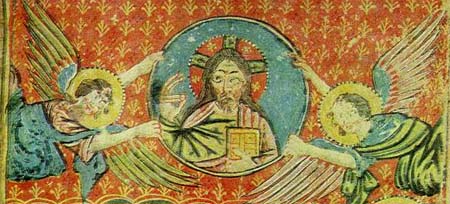
15th century,
Armenian illumination of the Resurrection Gospel
For the Armenians, and the Oriental Orthodox family of churches, the divinity of the Christ and the humanity of Jesus are fully and completely intermingled in a single (not double) nature. This belief, in opposition to the Council of Chalcedon, is called "monophysitism" from the Greek monos meaning 'one, alone' and physis meaning 'nature.' ... 1500 years later and the question is no less mystifying!
My interview with the Patriarch concludes with an exchange of gifts. I offer a copy of the Quebec Cathedral tour booklet and our new DVD documentary. His Beatitude gives me several volumes of music and literature published at the Patriarchate's printing house. The following day, the Patriarch reports that he watched the DVD and quite enjoyed learning about the Cathedral of the Holy Trinity. He seems particularly fascinated with our Cathedral bells.
It is a distinct privilege to meet and converse with this great churchman of the Armenian Orthodox tradition.